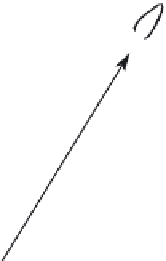Graphics Reference
In-Depth Information
e
e'
l
θ'
θ
θ
t
Figure 5.2.
This figure serves as a visual supplement to the calculations necessary for
the hair specular component. See Section 5.3.2.
5.3.2 Specular
The specular component from the hair lighting model described by [Kajiya and
Kay 89] is based on the Phong specular model [Phong 73], where light is reflected
off a hair strand based on the tangent direction of the hair. The tangent of the
hair fiber represents the tangent of the surface that the light will reflect off of.
See Figure 5.2 and the following derivation for the hair specular component:
K
s
cos(
e,e
)
p
θ
)
p
K
s
cos(
θ
−
K
s
(cos (
θ
)cos(
θ
)+sin(
θ
)sin (
θ
))
p
e
)+sin(
t, l
)sin (
t, e
))
p
,
K
s
((
t
·
l
)(
t
·
where
K
s
is the specular reflectance. The eye vector is represented with
e
, while
l
is the light vector and
e
is the corresponding reflection vector. the angle between
the hair tangent
t
and the light vector
l
is
θ
,and
θ
is the angle between the eye
vector
e
and the hair fiber tangent
t
.
5.3.3 Practical Real-Time Hair Lighting
Given the defined diffuse and specular hair shading components and Marschner's
more analytical approach, Scheuermann presents a phenomenologically derived
hair lighting model [Scheuermann 04]. Figure 5.3 shows the dual specular high-
lights in a real-world image that the Scheuermann model attempts to reproduce.






















